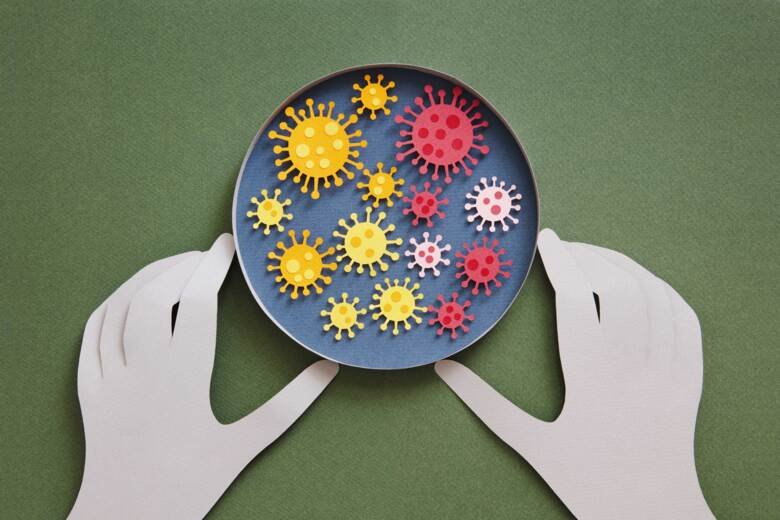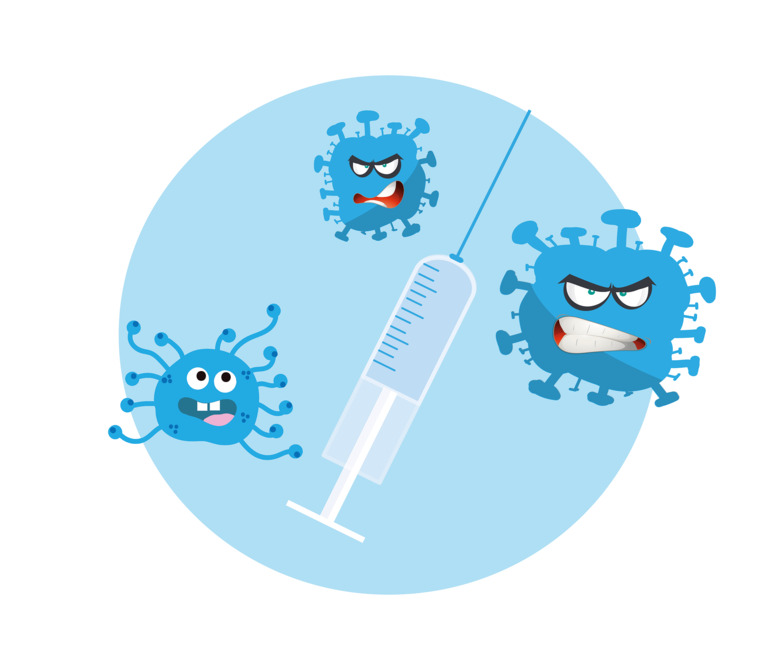How virus variants evolve

Hopefully we are nearing the end of the pandemic. But the virus is still there and scientists expect that new variants may emerge. Making us more sick, however, is not on the viral agenda.

Text: Ola Danielsson, written in Swedish for the magazine Medicinsk Vetenskap no. 1 2022
A virus lacks both intelligence and will, and yet they seem intent on infecting us. Why do more transmissible variants keep appearing? And what can make this ball of spikes less prickly?
The answer lies in evolutionary processes that we are witnessing now in realtime, explains Jan Albert, professor of infectious disease control at the Department of Microbiology, Tumour and Cell Biology, Karolinska Institutet.
“Viruses mutate as they copy their DNA and produce a great number of new variants, at which point Darwin’s laws take over,” he says.
A matter of natural selection
Charles Darwin hit on the idea that life forms evolve through a simple process of natural selection. In every population of animals there is a variety of characteristics. Those that increase the likelihood of reproduction generally become more common, while those that reduce the chances of reproduction die out.
It’s the same with viruses – but they have certain peculiarities. A virus’s characteristics do not primarily emerge through the combination of the genes of two parents, as happens when we humans have babies. It is more a case of carelessness when they replicate.
“Most mutations are bad for the virus and quickly disappear,” explains Professor Albert. “Some are neutral and whether they survive or not is quite random. Other mutations however, improve the virus in one way or another. These will be selected by evolution and live on.”
Two different viruses can also merge, and although such recombination is unusual it can lead to great evolutionary leaps. In December 2021 there were media reports that Delta and Omicron could have produced such an offspring: “deltacron”. It soon turned out, however, to be a case of contamination of sequences in a laboratory.
Many ways to spread
The definition of success for a virus is to spread. They are wholly dependent on the host cells for the ability to replicate and spread. But a virus must also be able to spread from one host to another.
A virus can increase its innate transmissibility in many ways, such as by becoming more effective at binding to receptors on host-cell surfaces and entering the cells, producing more viral particles per cell or leaving our cells or bodies more quickly. As more people become infected and ultimately immune, viruses able to evade the immune system are at an evolutionary advantage.
Viral variants can co-exist – sometimes in one and the same host. With HIV, rampant evolution occurs within each infected person; patients who have been infected for a long time carry thousands of them.
But they can also eliminate each other. If a fast-spreading variant can infect individuals who are immune to other variants, it increases its chances of taking over completely.
The new coronavirus variants have all had an increased degree of transmissibility, as would be expected. But there have also been some surprises.

Surprising variants
“In the early days of the pandemic, it was commonly thought that the relatively low mutation rate of SARS-CoV-2 meant we need not worry that it would diversify quickly, but this turned out to be a misunderstanding,” says Ben Murrell, researcher at the Department of Microbiology, Tumor and Cell Biology, Karolinska Institutet.
Coronavirus mutates when base pairs in the RNA string randomly get deleted, added or replaced. The rate of change is approximately one base pair every 15 days. Other RNA viruses are generally known for mutating relatively quickly; SARS-CoV-2, however, is equipped with a mechanism that corrects erroneous replicants, which slows the mutation rate.
The virus spent its first months almost completely unchanged. Until, that is, mutated variants suddenly appeared at several places simultaneously.
“We don’t fully understand why this happened,” says Dr Murrell. “It could have been because everyone lacked immunity at first, so the virus could spread unhindered. But when a sufficient proportion of the population had been infected, a similar evolutionary pressure on the virus could have emerged at many places at the same time.”
It started with the discovery of the Alpha and Beta variants by scientists in the UK and South Africa. It wasn’t long before their cousin Gamma showed up in Brazil. They had some mutations on the spike protein in common and all were more transmissible than earlier variants.
Many people thought that the next problem variant would be an offspring of Alpha, the most infectious of the three. But the Delta variant, first discovered in India, had evolved of its own accord and become many times more transmissible than the original virus.
Then came the next surprise – Omicron. It too was entirely unrelated to previous SARS-CoV-2 variants, but with an extremely rapid transmission rate and more than 30 new mutations on the spike protein.
Facts about virus surveillance
Mutations in the virus’s DNA are being monitored in laboratories around the world. In Sweden, the Public Health Agency is tracking viral variants and gathering sequencing data from different laboratories, amongst them clinical laboratories at the seven university hospitals, SciLifeLab and the National Pandemic Centre at Karolinska Institutet, where roughly 70 of the sequencing takes place.
The world is swarming with SARS-CoV-2 variants, but only a few are a cause of concern to scientists. These Variants of Concern (VOC) fulfil at least one of three criteria:
- Increased transmissibility or other change that affects the spread of disease.
- A worsening of or change in symptoms.
- Reduced effect of vaccine, treatment or diagnosis.
Source: ECDC, SciLifeLab, and others.
The unknown background of Omicron
Scientists don’t know how Omicron was able to accumulate so many mutations before it was discovered in South Africa.
“A likely explanation is that it evolved in a patient with compromised immunity who had been carrying the infection for a long time,” says Dr Murrell. “Continuous replication under the influence of the immune system would be able to explain many of the mutations we see in Omicron.”
Another possibility is that SARS-CoV-2 jumped back into another species, mutated, and then jumped back into humans.
The researchers are also not fully sure why Omicron spreads so quickly. One theory is that the variant enters the cell differently.
The virus uses it spike proteins to enter cells. But first the spike needs to be cleaved by an enzyme called furin in the host cell. There is, however, another way into the cell through an organelle called the endosome, a process that is more effective if the protein is not cleaved.
The high transmissibility of the Delta variant could be related to the greater cleavability of its spike protein. When Omicron appeared, many scientists thought that it used the same mechanism, but better.
“But now we know that Omicron behaves differently,” Dr Murrell says. “The spike protein is cleaved to a lesser extent, and it uses the endosomal route of entry more efficiently, but we don't yet understand how.”
Avoids neutralizing antibodies
Part of the explanation is also that it sneaks past the immunity that has been built up against earlier variants or against vaccines based on the original variant’s spite protein.
Working alongside Professor Albert, Dr Murrell’s research group managed to clone Omicron’s spike protein from blood samples taken from patients with suspected Omicron. Their results showed that neutralising antibodies, which prevent the virus entering cells, are less effective against Omicron than the original SARS-CoV-2 variant.
“Omicron avoids neutralizing antibodies very well. This means that you probably become infected more easily,” he continues.
However, the antibody response was not quite as bad as most people had expected. Some people had antibodies that also worked against omicron, especially if they had been previously infected and then vaccinated.
“Subsequent work by other labs has now shown that a similar effect is achieved by a 3rd booster vaccine dose, even though the vaccine still uses a spike from the original founder variant,” Dr Murrell says.

Still recognised by T-cells
To completely evade the immune defence, the virus would also need to cheat T cells. In January 2022, researchers at Karolinska Institutet showed that T cells formed on infection with the original variant, or vaccination, still recognise Omicron.
“Taken together with viral factors, such as that the Omicron variant prefers to propagate in the upper airways rather than the lower, and other immunological factors, these results give us a clearer picture that may explain why the protection against severe omicron disease remains good in previously mRNA-vaccinated individuals,” says Marcus Buggert, researcher at the Department of Medicine, Karolinska Institutet (Huddinge).
Professor Albert believes that we can expect more variants of SARS-CoV-2, but doubts that its transmissibility can become much greater. Omicron’s transmissibility seems to be comparable with measles, which makes it one of the most infectious viruses in the world.
Unlike the original virus, the new variants operate in an environment in which a great many people have been vaccinated or have already contracted the disease. He thinks it is therefore likely that future variants will try to compete by evading the immune system and draws comparisons with influenza:
“We get epidemics of flu every winter because the virus changes so that it can infect some of the individuals who’ve been infected previously.”
It is also known that our antibodies are more effective against earlier years’ flu variants and less so against coming variants.
But what does this mean for our health? Does an evolutionarily successful virus variant make us more, or less, sick?

The virus doesn´t care about our health
Jonas Klingström, a researcher at Karolinska Institutet’s Department of Medicine in Huddinge looking into the pathogenic properties of coronavirus, reasons that while it is not in the virus’s interests, so to speak, to make us seriously ill, it also has nothing to gain by letting us remain healthy.
“The virus doesn’t care about how sick we get, only about how quickly it can spread. Sure, the virus that takes over might well cause milder symptoms, but there’s no reason to assume that this have to be what happens,” he says.
Omicron appears to be less virulent than earlier variants.
“Omicron replicates more easily in bronchial cells high up the airways than it does in deeper lung tissue, which could be why the disease is milder,” says Dr Klingström.
Beta, Gamma and Delta, however, were more infectious but just as virulent.
Dr Klingström sees no evolutionary reason for the virus to mutate and suddenly cause more severe disease. And it must be remembered the virulence is not the same as infectiousness.
“We still don’t really know why this virus causes disease, but generally speaking the different viruses have produced the same type of symptoms,” he says.
Just because the virus mutates, it does not mean that it will end up altering all its characteristics.
“Important differences have accumulated on the spike protein, which is the tool the virus uses to enter our cells. In all other respects the variants are fairly identical, so there shouldn’t be any real differences in how they affect the infected cells or manipulate the immune defence,” he continues.
Ben Murrell also sees no simple connection between disease severity and the development of the different variants.
One argument that has been advanced during the pandemic is that it is detrimental to a virus to kill its host, because it renders it unable to spread and so will gradually become less virulent. But Dr Murrell is sceptical.
“That argument doesn’t apply to this case. Death occurs so late after infection, it’s not relevant,” he says. “People aren’t dying before they’ve had a chance to spread the virus. So, while there may be other reasons a virus might evolve to become less severe over time, this argument does not work.”
We also, he points out, have a poor grasp of the time perspective. Whether the virus will have become less virulent in a hundred years’ time gives us little comfort today.
Influenza viruses have become milder
Professor Albert agrees that that we cannot count on the virus becoming milder as time goes on.
“One example is the measles virus, which is thought to have been infecting humans for over 5,000 years and which is still seriously virulent,” he says.
But he also reminds us that some of the viruses responsible for other pandemics have in fact become milder, such as H1N1, the virus that caused the Spanish flu.
“They’ve exhumed bodies from the permafrost and recreated the original virus, which proved much more aggressive than its descendents that continued as seasonal influenza.”
Most seasonal influenza viruses began as pandemics (see timeline). While it is above all the Spanish flu virus that seems to have become less virulent, it is thought the others have become less dangerous because greater popular immunity has reduced their infectiousness.
The four other coronaviruses besides SARS-CoV-2 that are circulating usually produce milder respiratory symptoms, but their history is less well charted.
Timeline: The evolution of the flu
1889–1890: Russian flu (type unknown).
1918–1920: Spanish flu pandemic (H1N1).
Remained as a less virulent seasonal influenza until 1957.
1957–1958: Asian flu pandemic (H2N2).
Displaced the Spanish flu virus and became a seasonal influenza until 1968.
1968–1969: Hong Kong flu pandemic (H3N2).
Displaced the Asian variant and became a seasonal variant that is still active.
1977–1979: A descendent of the Spanish flu virus (H1N1) returns.
Probably due to a laboratory leak. Remained as a seasonal influenza until 2009 alongside Hong Kong descendents.
2009: Swine flu pandemic (new H1N1 variant).
Displaced the old H1N1 variant and remains as a seasonal influenza until 2009 alongside Hong Kong descendents.
Today: Descendents of swine flu (H1N1) and the Hong Kong flu (H3N2).
Co-exist as a seasonal influenza alongside two variants of influenza B.
Source: Jan Albert
According to Professor Albert, SARS-CoV-2 is in an erratic period in which it is exploring many possible evolutionary paths. After a few waves of infection, he believes that it will stabilise and mutate more predictably.
The influenza virus is also a RNA virus that continually mutates, but these new variants are minor modifications of previous years’ variants that are to some degree predictable, not heavily mutated relatives that appear unexpectedly.
“SARS-CoV-2 is turning into something resembling the other respiratory viruses that circulate annually,” he says. “There are no guarantees and we’re not there yet, but it’ll eventually be time to start regarding SARS-CoV-2 as just another respiratory virus.”
Dr Klingström believes that there are more variants to come, but there will be no drastic change in their virulence. There are other concerns that trouble him more:
“I’m more worried about ‘virus X’, a future virus that will start at zero will have completely different properties. SARS-CoV-2 has, after all, a relatively low mortality rate and in that sense it’s a good rehearsal for a possible worse pandemic in the future.”

Risk for variants regardless of vaccine
When people are vaccinated, it can influence the evolution of the virus and benefit variants able to evade immunity. Scientists are therefore trying to work out which vaccination strategy is best, given this effect.
But the problem arises in the absence of vaccines, too.
“There are two options: either the population is not vaccinated, in which case the virus has to contend with natural immunity, or the population gets vaccinated, which also provides an immunity for the virus to fight,” says Professor Albert.
Vaccines are often based on earlier viral variants than the current ones and can therefore need updating. For instance, the COVID vaccine is based on the original variant, not omicron.
Natural immunity emerges to the more recent variant and is therefore more “updated”, even if this is no guarantee against future infections.
The great advantage of a vaccine, Professor Albert explains, is that it protects against severe disease. It can also help to reduce transmission, which in turn makes new variants less likely.
“If there are no infections, there’ll be no new dangerous variants. These mainly appear in large infected populations,” he says.
